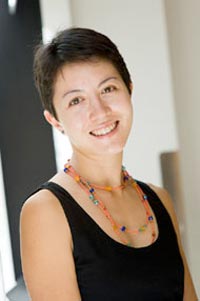This is the latest in a series of profiles of our MIT Energy Fellows—graduate students who are supported by MIT Energy Initiative (MITEI) members to participate in faculty-led research and become part of a long-term community of students and alumni.

Sitting on a hillside overlooking Honolulu and 1,000 miles of ocean, Karen Noiva Welling was struck by how the island, if somehow cut off from the outside world, could not provide enough food, fuel, or water for its inhabitants. Welling was inspired to help society—especially in places that have more control over their environment than islands—move toward sustainability.
Armed with an undergraduate MIT degree in mechanical engineering, Welling now plans to research resource consumption in the built environment and in urban communities. Welling, one of 47 MIT Energy Fellows supported by MITEI’s member companies, is sponsored by MITEI sustaining member Siemens.
In her graduate work she is using an approach called urban metabolism, which adopts a systemic view of the way cities consume resources. It provides a means of understanding and boosting sustainable development by thinking of cities as organisms that consume raw materials, fuel, and water and generate waste. Welling’s goal is to work in design and policy resource management and decision-making to benefit the environment, society, and businesses.
“Looking at patterns of energy consumption in urban environments is critical because cities are such big resource sinks and major sources of pollution in water and air,” she said. “A lot of cities are looking at options for retrofitting buildings. We’re interested in helping do this by conducting cost-benefit analyses and identifying technologies. The technologies you would use in LA are not same ones you would use in Boston.
“The big questions in this field revolve around how cities choose sustainable strategies and how they implement them,” she said.
Installing solar rooftop arrays, shading windows to reduce heat gain and loss, and re-using hot water in multiple systems are just some of the cost- and energy-saving technologies becoming more widely available to architects and urban planners. Increased use of vegetation and wide-scale recycling can also influence energy consumption.
Working in the Building Technology Program with John E. Fernandez, associate professor of architecture, Welling hopes her research will inform public and private management decisions on energy and resource use in the built environment and in urban communities. “The real challenge is integrating all the different fields to help cities get the tools and knowledge they need to start implementing big changes,” she said.
Fragile ecosystems
Growing up in suburban Connecticut, Welling said “there wasn’t a big push for me to be environmentally conscious.” But frequent visits to her grandmother’s house in bucolic Ludlow, Vt., helped her develop a connection with nature that was cemented when, early in her undergraduate years at MIT, she spent a year at the University of Hawaii at Manoa.
There, in a lush valley on O’ahu, an island so compact it bridged mountains to sea in fewer than 10 miles, the impact of humans on nature seemed more visible than it did on the mainland, Welling said. “When the only water you get comes from the sky, water use is something a lot more people think about.”
Her newfound awareness of the impact of humans on the global environment sparked a desire to turn toward engineering. “It made me want to use my education to help society move toward sustainability—and that’s what engineers do, come up with solutions—but I was always interested in ecology and I’ve always been in interested in people and history and social dynamics. I’m excited to have the opportunity to combine all of these interests in the field of urban metabolism, a very integrated field.”
Enlightening treks
To feed a long-time interest in traveling, the summer before her senior year, Welling and traveling companions set off on a cross-country bike trip from Oregon to Washington, DC. Two years later, an expanded group of friends embarked on another bike tour, this one taking four months to cover 3,500 miles from Cape Town, South Africa, to Dar es Salaam, Tanzania.
Welling recalls a 300-km section of northern Botswana where they saw almost no other people, the sound of their tires on the rutted dirt roads startling elephants, zebras and giraffes. “Africa definitely spoke to me. I went there to experience the culture, and despite the challenges posed by Africa’s many languages, the people made an impression on me.
“Traveling in Africa, one of the major lessons I took away is that while developing countries are critical for developing global sustainability, their path to a more sustainable economy is not clearcut,” she said. “Not only do their economies not support expensive new technologies or concerted efforts toward sustainability, their economies often depend on extraction of their prime resources.”
Welling completed her bachelor’s degree in mechanical engineering at MIT in 2008. She concentrated on sustainability in mechanical engineering but had not heard of urban metabolism until she applied to the master of science in building technology graduate program. “I have a lot of different interests and they don’t always fit together very neatly.” On her current path, she said, “I feel like all my efforts come together.”